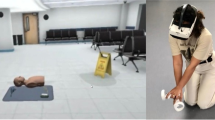Abstract
Immersive virtual environments are increasingly used for medical training and rehearsal. Immersive environments can provide realistic context for team training, where success relies on practiced coordination between individual members. Using immersive virtual environments, medical teams can practice in situations that would otherwise be difficult or expensive to create. It has been shown that individuals perform poorly when the training environment differs significantly from practice 2005. Efforts have been made to close this gap using virtual environments. Interacting in a virtual space requires a robust locomotion paradigm. Locomotion paradigms are methods that allow an individual to move and navigate through virtual environments. Locomotion paradigms should be intuitive to the user, and not distract from the central task of medical training. In this paper, we describe and evaluate four locomotion paradigms, Look & Go, Push & Go, Point & Go, and Grab & Drag, using objective metrics to evaluate navigational efficiency. This study was performed with 98 volunteers predominantly of clinical backgrounds. With the comparison between the performances of game-playing and non-game-playing subjects, we have shown that game-playing experiences do not significantly affect the locomotion performances with the four proposed paradigms. The results of this study suggests the Grab & Drag as the best method among four locomotion paradigms in triage/trauma scenarios, where trainees need to find and help patients scattered in a large area.
Similar content being viewed by others
References
Alverson, D., Jr., Caudell, T., Summers, K., Panaiotis, S.S., Sherstyuk, A., Nickles, D., Holten, J., Goldsmith, T., Stevens, S., Mennin, S., Kalishman, S., Mines, J., Serna, L., Mitchell, S., Lindberg, M., Jacobs, J., Nakatsu, C., Lozanoff, S., Wax, D., Saland, L., Norenberg, J., Shuster, G., Keep, M., Baker, R., Stewart, R., Kihmm, K., Bowyer, M., Liu, A., Muniz, G., Coulter, R., Maris, C., Wilks, D.: Distributed immersive virtual reality simulation development for medical education. J. Assoc. Int. Med. Sci. Educ. 15, 19–30 (2005)
Bowman, D., Koller, D., Hodges, L.: A methodology for the evaluation of travel techniques for immersive virtual environments. Virtual Real.: Res. Devel. Appl. 3(2), 120–131 (1998). URL citeseer.ist.psu.edu/mine97moving.html
Bowman, D.A., Koller, D., Hodges, L.F.: Travel in immersive virtual environments: an evaluation of viewpoint motion control techniques. In: Virtual Reality Annual International Symposium, pp. 45–52 (1997)
Caudell, T., Summers, K., Holten, J., Hakamata, T., Mowafi, M., Jacobs, J., Lozanoff, B., Lozanoff, S., Wilks, D., Keep, M., Saiki, S., Alverson, D.: Virtual patient simulator for distributed collaborative medical education. Anat. Rec. Part B: New Anat. B 270, 23–29 (2003)
Darken, R.P., Allard, T., Achille, L.B.: Spatial orientation and wayfinding in large-scale virtual spaces II. Presence: Teleoperators Virtual Environ. 8(6), 3–6 (1999)
Darken, R.P., Cockayne, W.R., Carmein, D.: The omni-directional treadmill: a locomotion device for virtual worlds. In: Proceedings of UIST, pp. 213–221 (1997)
Hollerbach, J.M.: Locomotion interfaces. In: Handbook of Virtual Environments: Design, Implementation, and Applications, pp. 239–254. Lawrence Erlbaum Associates, Hillsdale (2002)
Iwata, H.: The torus treadmill: realizing locomotion in VEs. IEEE Trans. Comput. Graph. Appl. 19(6), 30–35 (1999)
Johnston, C.L., Whatley, D.: Pulse!!—a virtual learning space project. Stud. Health Technol. Inform. 119, 240–242 (2006)
Kaufman, M.: Team training of medical first responders for CBRNE events using multiplayer game technology. In: Proceedings of Medicine Meets Virtual Reality (2006). http://www.forterrainc.com
Kaufman, M., Dev, P., Youngblood, P.: Application of multiplayer game technology to team-based training of medical first responders. In: The Interservice/Industry Training, Simulation & Education Conference (I/ITSEC) (2005)
Mason, A.H., Walji, M.A., Lee, E.J., MacKenzie, C.L.: Reaching movements to augmented and graphic objects in virtual environments. In: Proceedings of the Conference on Human Factors in Computing Systems (CHI 2001), pp. 426–433 (2001)
Mine, M.R.: Virtual environment interaction techniques. Technical Report TR95-018, Department of Computer Science, UNC Chapel Hill (1995)
Mine, M.R., Brooks, F.P., Jr., Sequin, C.H.: Moving objects in space: Exploiting proprioception in virtual-environment interaction. Comput. Graph. 31, 19–26 (1997). URL citeseer.ist.psu.edu/mine97moving.html
Poupyrev, I., Billinghurst, M., Weghorst, S., Ichikawa, T.: The Go-Go interaction technique: Non-linear mapping for direct manipulation in VR. In: ACM Symposium on User Interface Software and Technology, pp. 79–80 (1996). URL citeseer.ist.psu.edu/poupyrev96gogo.html
Poupyrev, I., Weghorst, S., Billinghurst, M., Ichikawa, T.: Egocentric object manipulation in virtual environments: Empirical evaluation of interaction techniques. Graph. Forum 17(3), 41–52 (1998)
Scerbo, M., Weireter, L., Bliss, J., Schmidt, E., Hanner, H.: An examination of surgical skill performance under combat conditions using a mannequin-based simulator in a virtual environment. In: NATO RTO Human Factors in Medicine, St. Pete Beach, FL (2005)
Templeman, J.N., Denbrook, P.S., Sibert, L.E.: Virtual locomotion: walking in place through virtual environments. Presence: Teleoperators Virtual Environ. 8(6), 598–617 (1999)
Usoh, M., Arthur, K., Whitton, M., Bastos, R., Steed, A., Slater, M., Brooks, F.: Walking > walking-in-place > flying, in virtual environments. In: Proceedings of SIGGRAPH, pp. 359–364 (1999)
Virtual Reality Laboratory, University of Tsukuba, Japan. http://intron.kz.tsukuba.ac.jp/
Whitton, M., Cohn, J., Feasel, J., Zimmons, P., Razzaque, S., Poulton, S., McLeod, B., Brooks, F.: Comparing VE locomotion interfaces. In: Proceedings of IEEE Virtual Reality, pp. 123–130 (2005)
Wiederhold, M.D., Wiederhold, B.K.: Training combat medics using VR. In: Proceedings of CyberTherapy (2004)
Author information
Authors and Affiliations
Corresponding author
Rights and permissions
About this article
Cite this article
Lee, C.H., Liu, A. & Caudell, T.P. A study of locomotion paradigms for immersive medical simulation environments. Vis Comput 25, 1009–1018 (2009). https://doi.org/10.1007/s00371-009-0356-y
Published:
Issue Date:
DOI: https://doi.org/10.1007/s00371-009-0356-y




